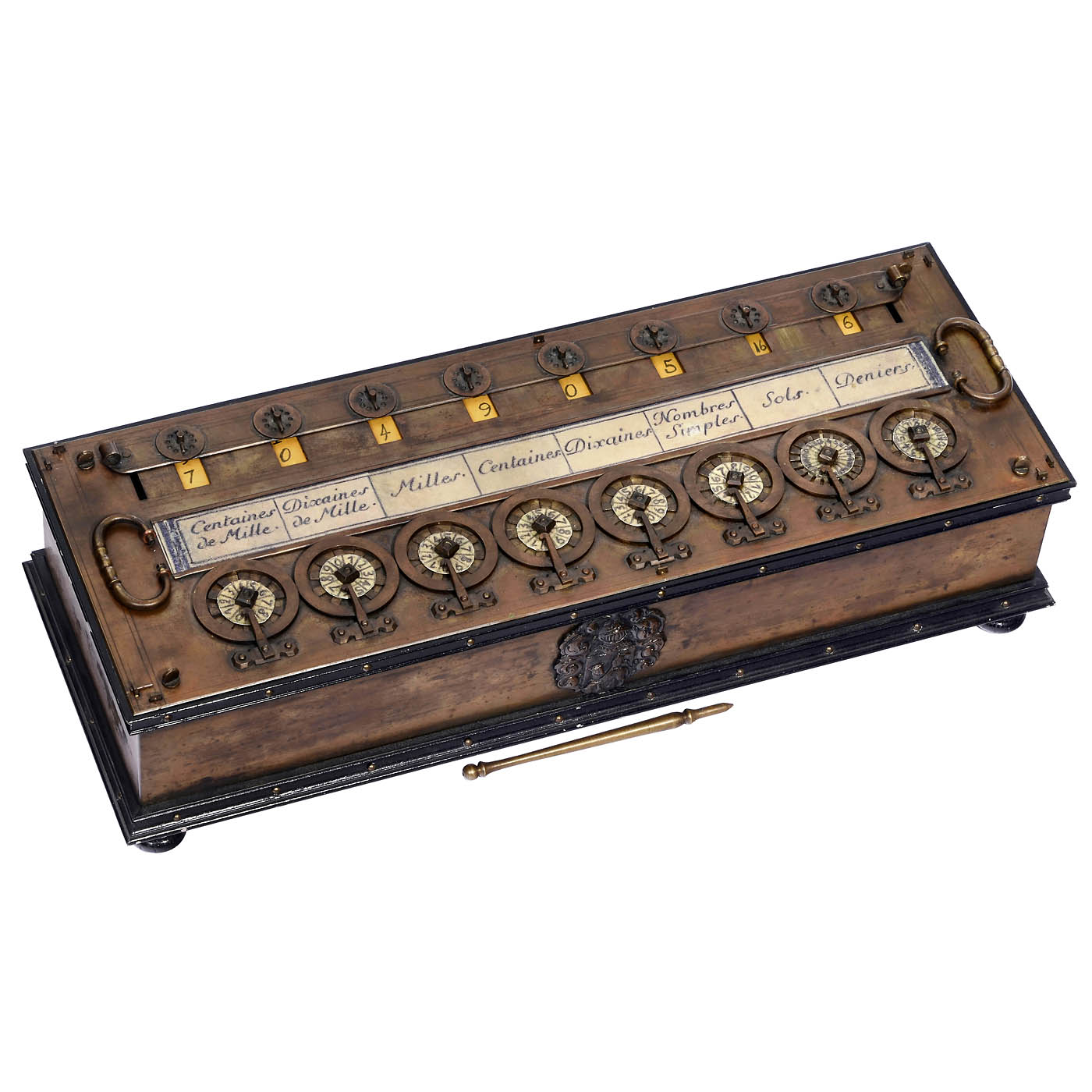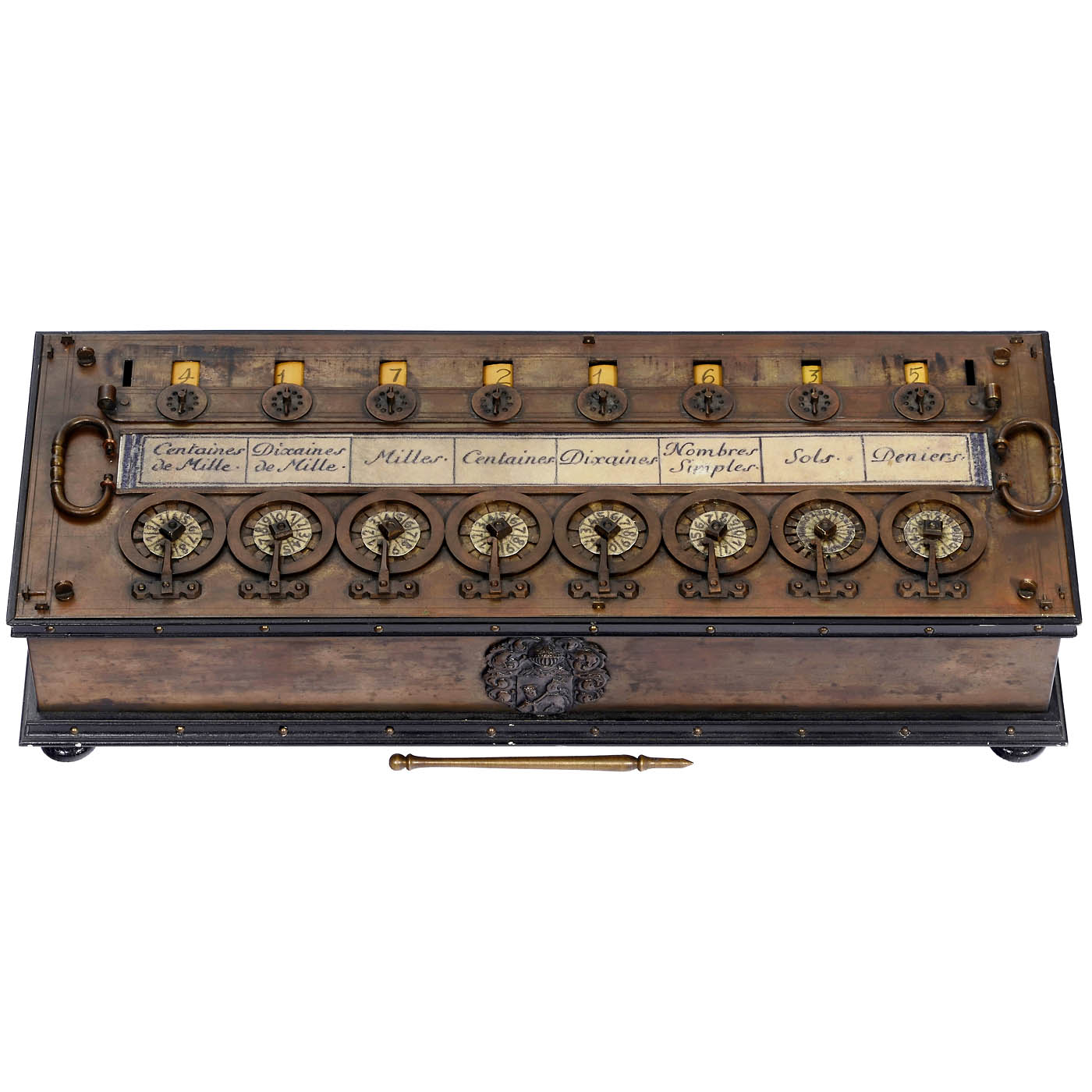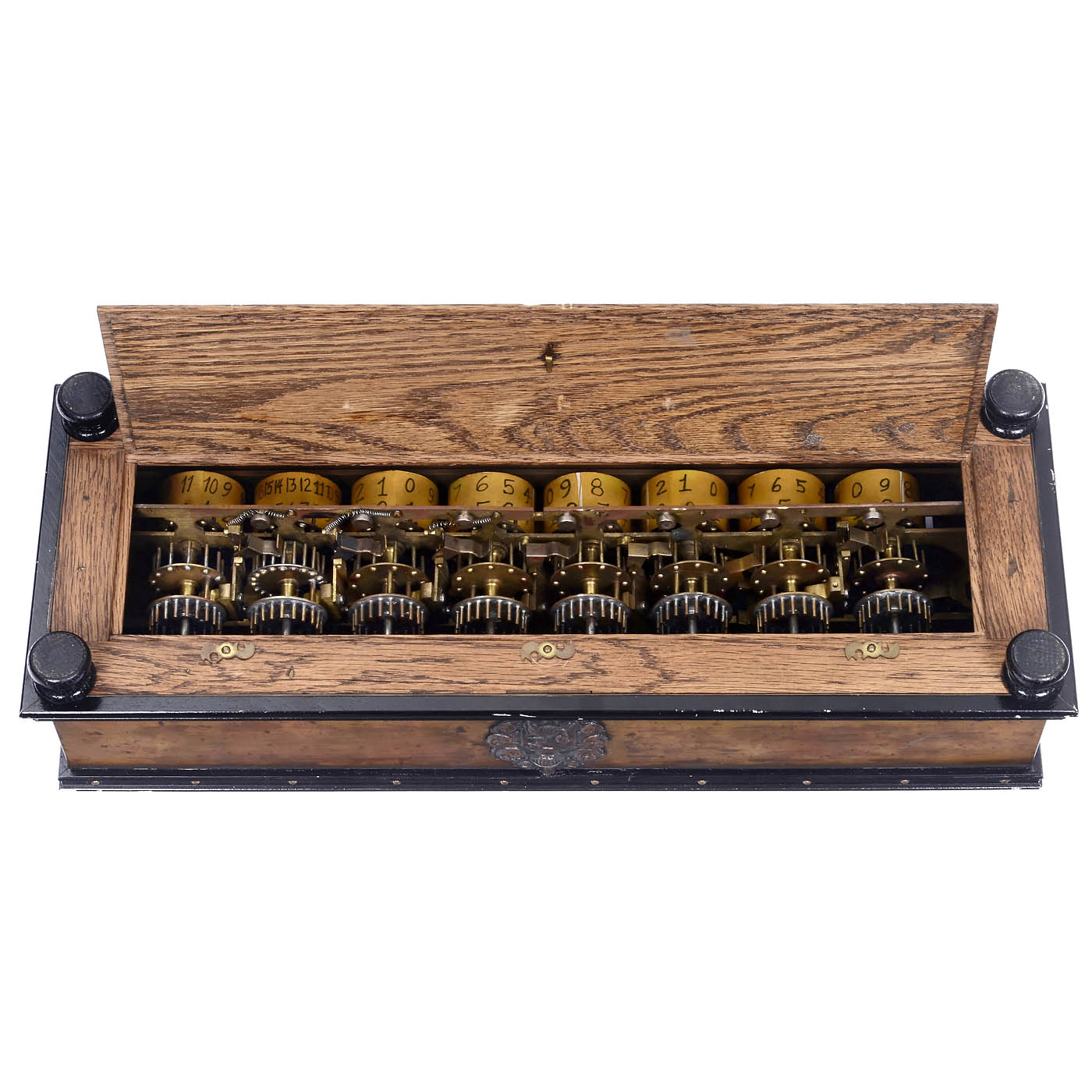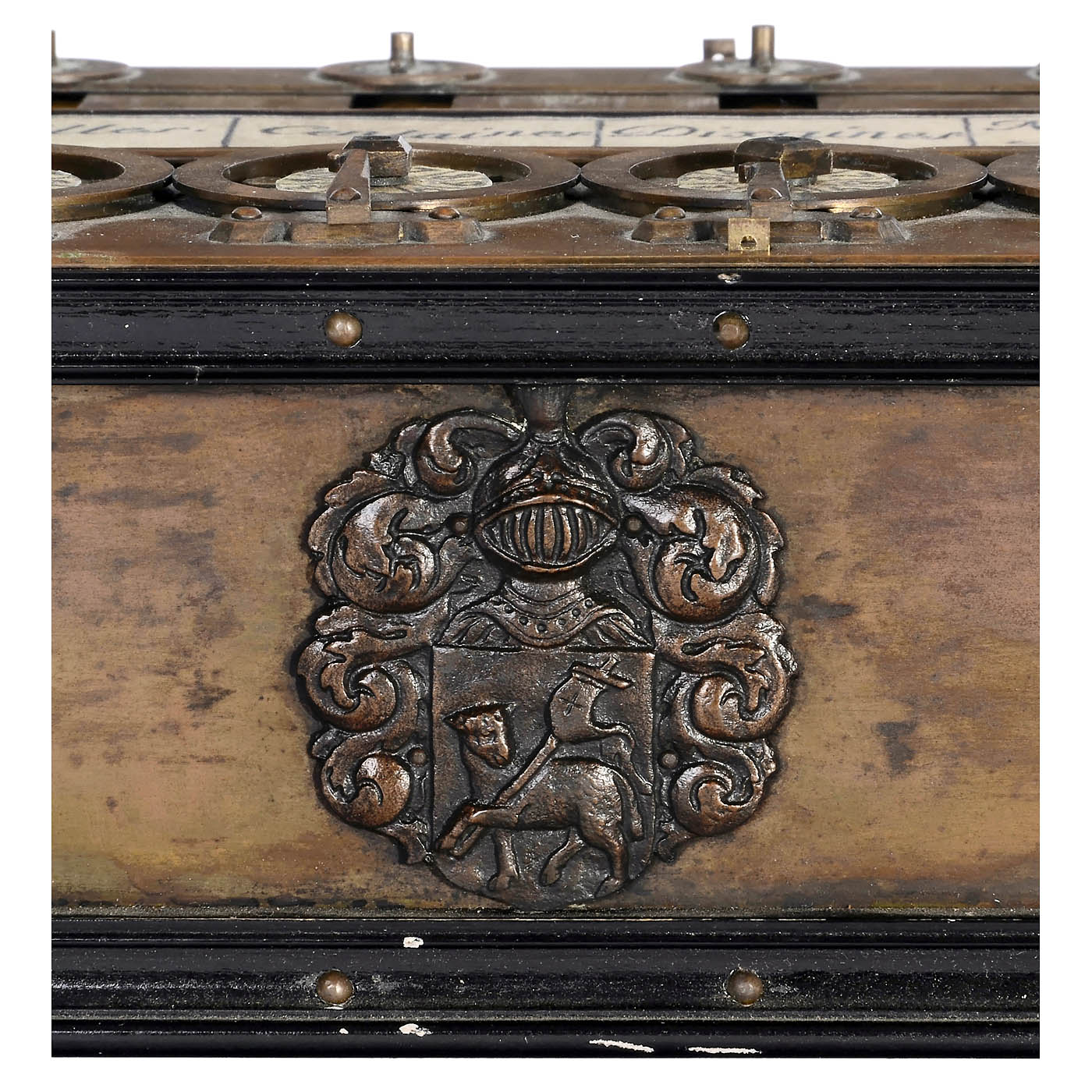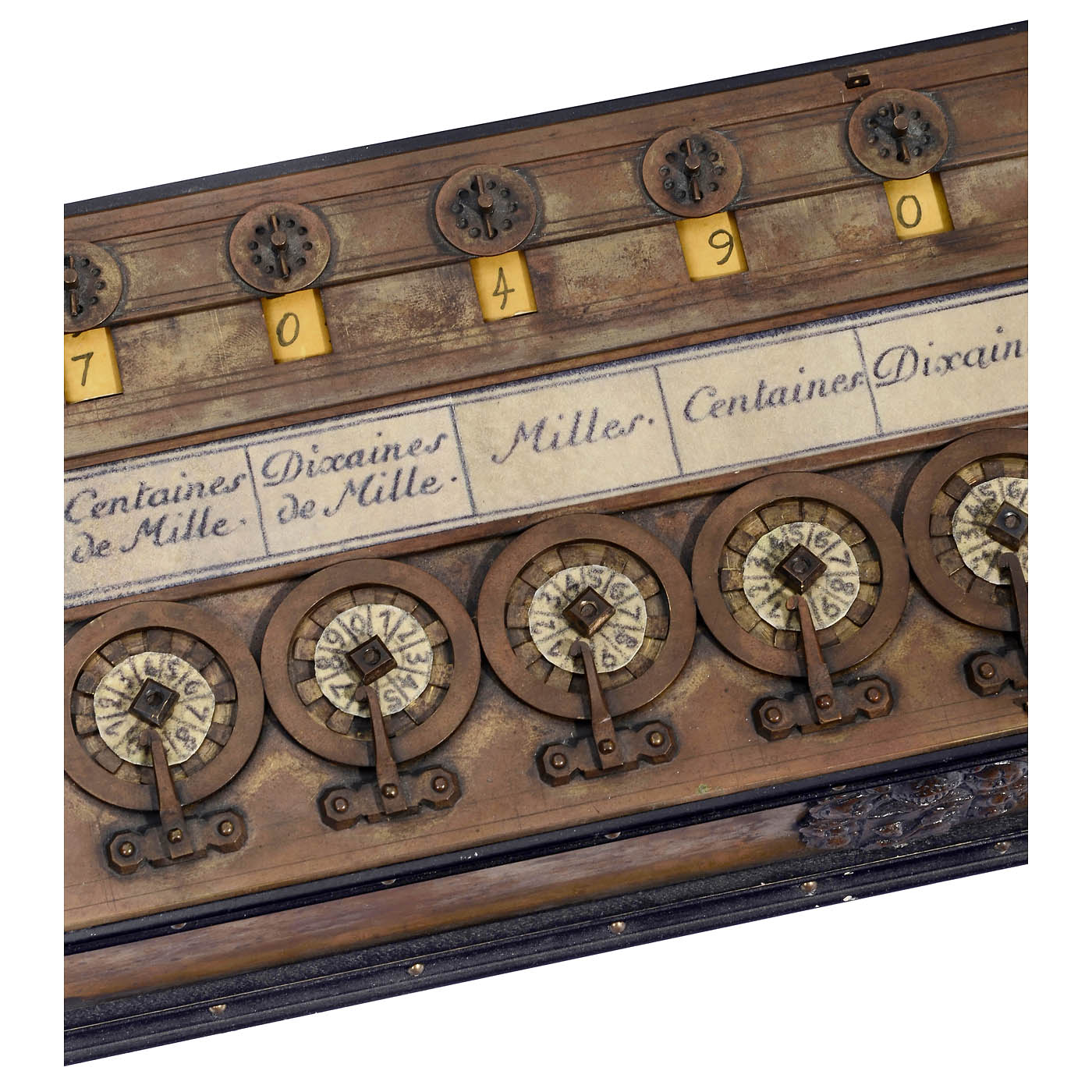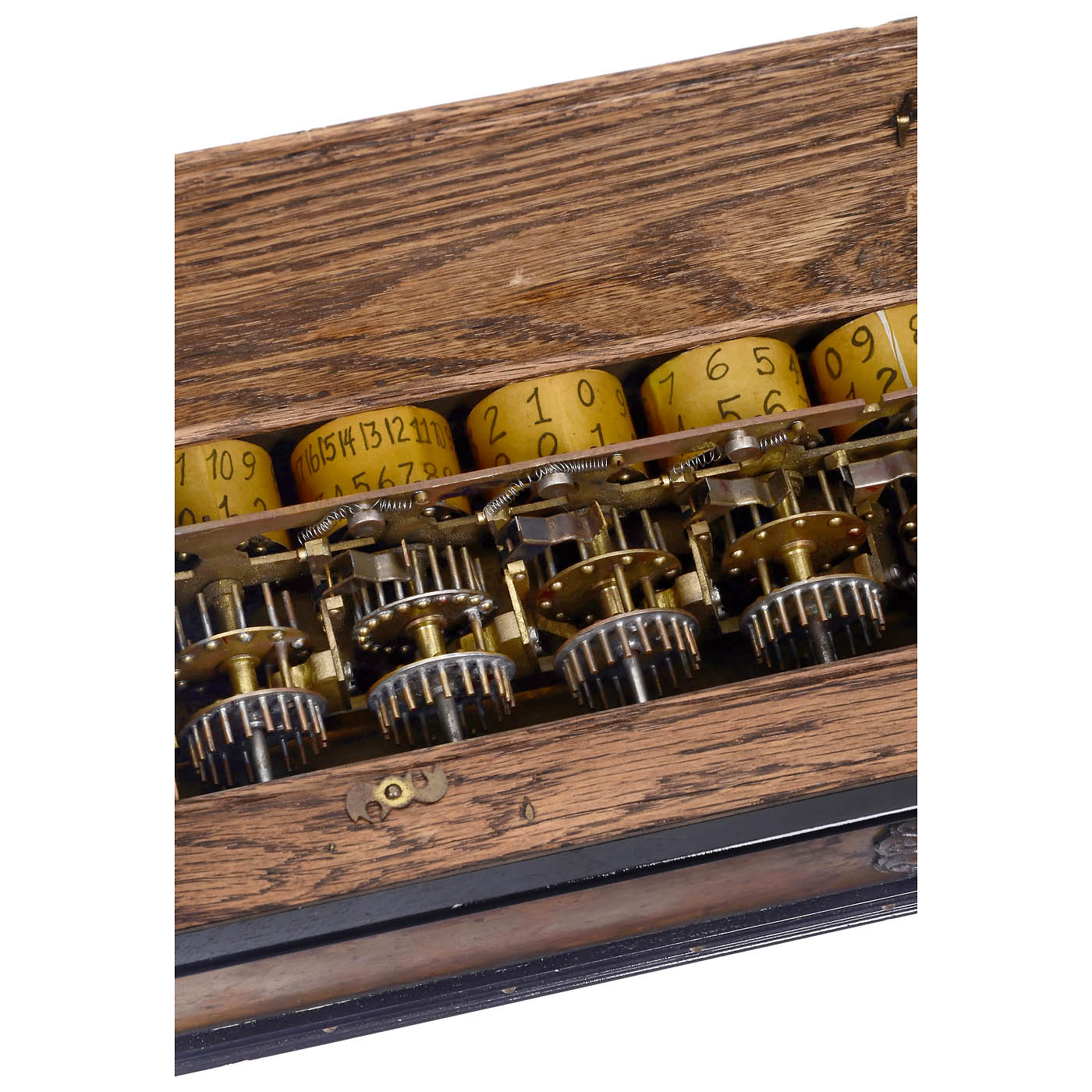88
"Pascaline" (or "Arithmatique") Replica
Legendäre erste mechanische Rechenmaschine der Welt des großen französischen Mathematikers und Philosophen Blaise Pascal, der 1623 in Clermont-Ferrand in der Auvergne geboren wurde. Bereits als Kind hatte er einige anerkannte fundamentale mathematische Lehrsätze entwickelt, zum Beispiel über geometrische Kegelschnitte. Blaise Pascal schrieb später zahlreiche mathematische Abhandlungen, er bewies die Abhängigkeit des Luftdrucks von der Höhe des jeweiligen Ortes, diskutierte die Frage des Vakuums gegen den Willen der Naturforscher und schuf die Grundlagen für die Entwicklung der Hydraulik ... - heute noch gültig als "Pascal'sches Gesetz". - Mit 19 Jahren entwickelte Blaise Pascal seine erste Rechenmaschine, nach zahlreichen zeitgenössischen Berichten sollen maximal 20 Stück je gebaut worden sein, wovon heute noch 9 Exemplare, ausschließlich in öffentlichen Museen, bekannt sind. - Die "Pascaline" ist für Addition sowie Subtraktion nach der Neuner- bzw. Zehner-Komplement-Methode (= addieren, um zu subtrahieren) konzipiert, da sie nur in einer Richtung gleichlaufende Zahnräder aufweist. - Zum Rechenvorgang: Dieser begann mit der Nullstellung aller Schaulöcher durch Verdrehen der Zifferräder. Zum Addieren wurde das an den Anzeigerollen befindliche Lineal nach oben geschoben. Die Anzeigerollen waren 2-reihig mit Ziffernfolgen gekennzeichnet. Die untere Reihe war nach rechts laufend steigend von 0 bis 9 (Addition) und in der oberen Reihe fallend von 9 bis 0 (Subtraktion) ausgelegt. Für beide Rechenarten galt also die gleiche mechanische Handhabung: Ein Stift wurde in den Speichenzwischenraum der entsprechenden Ziffer des Einstellrades eingeführt und dann bis zum Anschlag herumgedreht. Zur Umschaltung von Addition auf Subtraktion wurde lediglich das Lineal nach unten geschoben. Die Arbeitsweise blieb die gleiche. Pascals Rechenmaschinen hatten von Anbeginn bereits Zehnerübertragung und konnten auch zur Multiplikation eingesetzt werden, was allerdings einem sehr mühsamen Unterfangen gleichkam. - Blaise Pascal erhielt 1649 für seine Rechenmaschine das "Royal Privilège", sie war damit die erste patentierte Rechenmaschine der Welt! Außerdem war die "Pascaline" auch die erste Rechenmaschine mit automatischer Zehnerübertragung, wie sie auch die erste Rechenmaschine in Serienproduktion war. Mit Blaise Pascal und seiner Rechenmaschine begann die Entwicklung der mechanischen Rechner, zunächst in Europa und dann weltweit, was schließlich nach mehr als 300 Jahren zur Erfindung des ersten Mikroprozessors führte, des "Intel 4004", der für den ersten Elektronen-Tischrechner der Welt, den "Busicom 141-PF" von 1971, entwickelt wurde. Die hier offerierte "Pascaline" ist ein absolut originalgetreuer Nachbau des Originals aus der IBM-Sammlung, hergestellt von dem Ingenieur Roberto A. Guatelli um 1981. Es handelt sich um eine 8-stellige Buchhaltungsmaschine für französische Währung. Der Aufbau besteht aus 6 x 10, 1 x 20 und 1 x 12 Stellen. Die am wenigsten signifikanten Stückelungen, Sols und Deniers, befinden sich auf der rechten Seite. Der 12er-, 20er-, 10er-Übertrag erfolgt über alle Positionen problemlos! Geschützt wird die "Pascaline" durch eine Schatulle aus Nußbaumholz. - Die "Pascaline" ist zweifellos eine Riesen-Rarität von hohem kulturellen wie wissenschaftlich-technischem Wert!
Start Price: EUR 7500
The "Pascaline" offered here is a faithful replica of the original from the IBM collection, by the engineer Roberto A. Guatelli c. 1981. It is an 8-digit accounting machine for French currency. The construction consists of 6 x 10, 1 x 20 and 1 x 12 digits. The least significant denominations, Sols and Deniers, are on the right hand side. The 12s, 20s, 10s carry over all positions without problem. The calculator is housed in a walnut case. -Blaise Pascal (1623-1662), mathematician, physicist and philosopher, is credited with the invention of the world's first mechanical calculator capable of addition and subtraction. His father, Étienne Pascal, was a lawyer and a judge in the tax court who assumed a new position as tax commissioner for Upper Normandy, based in Rouen, in 1639. France had declared war with Spain four years earlier, leading the French government to renege on part of its internal debt and to increase taxation. Étienne - assisted by his son - was under pressure to keep accurate account of the rising tax levies with only the help of counting boards. In 1642 the 19-year old Blaise Pascal began designs for a machine that would simplify his father's work. As a journalist wrote in "Le Figaro Littéraire" in 1947, "the calculating machine was born of a filial love flying to the rescue of the tax man". - Pascal's first design was for a five-digit calculator; he later refined his principal by creating six-, eight- and ten-digit machines. Due to the difficulty in cutting toothed gears accurately, Pascal used lantern-type gears formed by pinned wheels that could turn in one direction only. - His design was simultaneously simple and brilliant; the Pascaline could add and subtract two numbers directly and multiply and divide by repetition. The ten digit-wheels on the outer case are connected to axles that each carry three lantern gears and a paper-covered drum with inscribed figures. The digit-wheels were rotated by a stylus. For addition, a sliding rule located on the number display was pushed upwards for digits from 0 to 9. For subtraction, the rule was pushed downwards for digits from 9 to 0. - The "Pascaline" was also revolutionary for including digital carry-over. Whenever a ten was carried, a ratchet mounted between the gears, pushed the adjacent gear around a notch, so that the display moved one digit higher. Unfortunately for its operator, a design flaw meant that the ratchets were inclined to jam - perhaps one reason why production of the Pascaline was not financially successful at 100 livres apiece. It was, however, a mathematical sensation, leading Pascal's friend, the poet Charles Vion Dalibray, to compose a sonnet in its honor: "... Calculation was the action of a reasonable man, And now your inimitable skill. Has given the power to the slowest of wits". - Pascal accordingly applied for a privilege (the 17th century term for a patent), which was only eventually granted in 1649, after its inventor had presented the issuing officer, Chancellor Seguier, with an 8-digit calculator of his own. - The total production of the Pascaline is not known, however, researchers estimate that no more than twenty examples were produced, of which nine are known today. It was, nevertheless, an historic achievement, not least for demonstrating "that an apparently intellectual process like arithmetic could be performed by a machine". Its introduction led to the development of mechanical calculators in Europe and, eventually, to the invention of the very first microprocessor, the "Intel 4004", for the "Busicom 141-PF" electronic desk calculator in 1971. Understood in this way, the "Pascaline" is arguably world's earliest mechanical computer. - Literature: Stan Augarten, "Bit by Bit, An Illustrated History of Computers", 1984, pp. 22-30.
Start Price: EUR 7500
Legendäre erste mechanische Rechenmaschine der Welt des großen französischen Mathematikers und Philosophen Blaise Pascal, der 1623 in Clermont-Ferrand in der Auvergne geboren wurde. Bereits als Kind hatte er einige anerkannte fundamentale mathematische Lehrsätze entwickelt, zum Beispiel über geometrische Kegelschnitte. Blaise Pascal schrieb später zahlreiche mathematische Abhandlungen, er bewies die Abhängigkeit des Luftdrucks von der Höhe des jeweiligen Ortes, diskutierte die Frage des Vakuums gegen den Willen der Naturforscher und schuf die Grundlagen für die Entwicklung der Hydraulik ... - heute noch gültig als "Pascal'sches Gesetz". - Mit 19 Jahren entwickelte Blaise Pascal seine erste Rechenmaschine, nach zahlreichen zeitgenössischen Berichten sollen maximal 20 Stück je gebaut worden sein, wovon heute noch 9 Exemplare, ausschließlich in öffentlichen Museen, bekannt sind. - Die "Pascaline" ist für Addition sowie Subtraktion nach der Neuner- bzw. Zehner-Komplement-Methode (= addieren, um zu subtrahieren) konzipiert, da sie nur in einer Richtung gleichlaufende Zahnräder aufweist. - Zum Rechenvorgang: Dieser begann mit der Nullstellung aller Schaulöcher durch Verdrehen der Zifferräder. Zum Addieren wurde das an den Anzeigerollen befindliche Lineal nach oben geschoben. Die Anzeigerollen waren 2-reihig mit Ziffernfolgen gekennzeichnet. Die untere Reihe war nach rechts laufend steigend von 0 bis 9 (Addition) und in der oberen Reihe fallend von 9 bis 0 (Subtraktion) ausgelegt. Für beide Rechenarten galt also die gleiche mechanische Handhabung: Ein Stift wurde in den Speichenzwischenraum der entsprechenden Ziffer des Einstellrades eingeführt und dann bis zum Anschlag herumgedreht. Zur Umschaltung von Addition auf Subtraktion wurde lediglich das Lineal nach unten geschoben. Die Arbeitsweise blieb die gleiche. Pascals Rechenmaschinen hatten von Anbeginn bereits Zehnerübertragung und konnten auch zur Multiplikation eingesetzt werden, was allerdings einem sehr mühsamen Unterfangen gleichkam. - Blaise Pascal erhielt 1649 für seine Rechenmaschine das "Royal Privilège", sie war damit die erste patentierte Rechenmaschine der Welt! Außerdem war die "Pascaline" auch die erste Rechenmaschine mit automatischer Zehnerübertragung, wie sie auch die erste Rechenmaschine in Serienproduktion war. Mit Blaise Pascal und seiner Rechenmaschine begann die Entwicklung der mechanischen Rechner, zunächst in Europa und dann weltweit, was schließlich nach mehr als 300 Jahren zur Erfindung des ersten Mikroprozessors führte, des "Intel 4004", der für den ersten Elektronen-Tischrechner der Welt, den "Busicom 141-PF" von 1971, entwickelt wurde. Die hier offerierte "Pascaline" ist ein absolut originalgetreuer Nachbau des Originals aus der IBM-Sammlung, hergestellt von dem Ingenieur Roberto A. Guatelli um 1981. Es handelt sich um eine 8-stellige Buchhaltungsmaschine für französische Währung. Der Aufbau besteht aus 6 x 10, 1 x 20 und 1 x 12 Stellen. Die am wenigsten signifikanten Stückelungen, Sols und Deniers, befinden sich auf der rechten Seite. Der 12er-, 20er-, 10er-Übertrag erfolgt über alle Positionen problemlos! Geschützt wird die "Pascaline" durch eine Schatulle aus Nußbaumholz. - Die "Pascaline" ist zweifellos eine Riesen-Rarität von hohem kulturellen wie wissenschaftlich-technischem Wert!
Start Price: EUR 7500
The "Pascaline" offered here is a faithful replica of the original from the IBM collection, by the engineer Roberto A. Guatelli c. 1981. It is an 8-digit accounting machine for French currency. The construction consists of 6 x 10, 1 x 20 and 1 x 12 digits. The least significant denominations, Sols and Deniers, are on the right hand side. The 12s, 20s, 10s carry over all positions without problem. The calculator is housed in a walnut case. -Blaise Pascal (1623-1662), mathematician, physicist and philosopher, is credited with the invention of the world's first mechanical calculator capable of addition and subtraction. His father, Étienne Pascal, was a lawyer and a judge in the tax court who assumed a new position as tax commissioner for Upper Normandy, based in Rouen, in 1639. France had declared war with Spain four years earlier, leading the French government to renege on part of its internal debt and to increase taxation. Étienne - assisted by his son - was under pressure to keep accurate account of the rising tax levies with only the help of counting boards. In 1642 the 19-year old Blaise Pascal began designs for a machine that would simplify his father's work. As a journalist wrote in "Le Figaro Littéraire" in 1947, "the calculating machine was born of a filial love flying to the rescue of the tax man". - Pascal's first design was for a five-digit calculator; he later refined his principal by creating six-, eight- and ten-digit machines. Due to the difficulty in cutting toothed gears accurately, Pascal used lantern-type gears formed by pinned wheels that could turn in one direction only. - His design was simultaneously simple and brilliant; the Pascaline could add and subtract two numbers directly and multiply and divide by repetition. The ten digit-wheels on the outer case are connected to axles that each carry three lantern gears and a paper-covered drum with inscribed figures. The digit-wheels were rotated by a stylus. For addition, a sliding rule located on the number display was pushed upwards for digits from 0 to 9. For subtraction, the rule was pushed downwards for digits from 9 to 0. - The "Pascaline" was also revolutionary for including digital carry-over. Whenever a ten was carried, a ratchet mounted between the gears, pushed the adjacent gear around a notch, so that the display moved one digit higher. Unfortunately for its operator, a design flaw meant that the ratchets were inclined to jam - perhaps one reason why production of the Pascaline was not financially successful at 100 livres apiece. It was, however, a mathematical sensation, leading Pascal's friend, the poet Charles Vion Dalibray, to compose a sonnet in its honor: "... Calculation was the action of a reasonable man, And now your inimitable skill. Has given the power to the slowest of wits". - Pascal accordingly applied for a privilege (the 17th century term for a patent), which was only eventually granted in 1649, after its inventor had presented the issuing officer, Chancellor Seguier, with an 8-digit calculator of his own. - The total production of the Pascaline is not known, however, researchers estimate that no more than twenty examples were produced, of which nine are known today. It was, nevertheless, an historic achievement, not least for demonstrating "that an apparently intellectual process like arithmetic could be performed by a machine". Its introduction led to the development of mechanical calculators in Europe and, eventually, to the invention of the very first microprocessor, the "Intel 4004", for the "Busicom 141-PF" electronic desk calculator in 1971. Understood in this way, the "Pascaline" is arguably world's earliest mechanical computer. - Literature: Stan Augarten, "Bit by Bit, An Illustrated History of Computers", 1984, pp. 22-30.
Start Price: EUR 7500
163 Specialty Auction,Office-Antiques,Telephones,Photographica & Film,Science & Technology,Mechanical Music,Fairground Attractions,Steam Engines
Sale Date(s)
Venue Address
General delivery information available from the auctioneer
Local Pick-Up, In-House Shipping
Important Information
World's leading Specialty Auctions Important Specialty Auctions of Technical Antiques offer a wide range of important collector's items of high museum quality: Photographica & Film, Science & Technology, Office-Antiques, Telephones, Mechanical Music, Fairground Attractions and much more ....
Viewing by appointment only from Monday, 21 March 2022 onwards
Terms & Conditions
Auction conditions
1) The auction is carried out voluntarily under foreign name and on account of the customer.
2) The goods to be sold in the auction can be examined and checked at determined times before the auction – under the full responsibility and risk of the interested client. They will be put up for auction in the condition as they are without any liability for visible or hidden defects as well as for attributes; later claims of any kind cannot be taken into consideration. The descriptions in the catalogue are made to the best of our knowledge, but they are no guaranteed attributes in the sense of § 459 and following BGB. – Information ref. § 26 UStR is assured. – No right of return of any sold item, therefore please use the advantage of the previewing (also by your friends).
3) Normally the bids are increased in steps of 10 % of the initial price with a minimum of € 5.–. The auctioneer can deviate from this regulation in particular cases. The knocking down is done if no higher offer is made after the third repetition of the highest offer and if the limit price has been achieved.
4) The auctioneer can combine numbers, separate them, can offer them out of the sequence or can withdraw them. The bidding is done by showing the bidding number or by a written offer.
5) The auctioneer can refuse an offer; in this case the offer given right before remains binding. In case several persons make the same offer, the knocking down is decided by lot. In case of identical written offers, the computer makes the decision to the benefit of the first offer received. Decisive in this case is the point of time of its entry. If there is a disagreement on a knocking down or if an offer is made in time has been disregarded, the auctioneer can all the same knock down this bid and can follow-up the rights resulting out of this. He can also knock down to the next lowest bid or can start again with the initial bid of this lot.
6) The knocking down is binding. The goods must be immediately paid. The knocking down transfers the risk of possible losses, damages, mistakes to the purchaser. Each bidder buys in his own name and for his own account.
7) A premium of 21.8% plus 3% Live transaction fee has to be paid on the knocking down price. 16% tax has to be paid on the surcharge, i.e. the total surcharge amounts to 28.77%. The entire amount, which has to be paid by the purchaser, is immediately due and has either to be settled in cash, wire transfer or by guaranteed bank draft. In case of an acquisition by submittance of a written order, the payment has to be settled within 8 days after the invoice date.
8) The goods become the property of the purchaser only after the complete payment. The objects will only be delivered if the payment has been settled. Otherwise the goods are still the property of the consigner until complete payment. In case a payment does not reach the auctioneer in due time, the purchaser is liable without reminder for all resulting losses. Also without proof of a loss the interest for delay at the bank usual rate can be charged.
9) In case the payment is not settled in time or the objects are not taken, the auctioneer has the right either to demand the performance of the contract of purchase or can claim damages due to the non-performance. Independent from the above the auctioneer can also put this object for auction in one of the next auctions on cost of the purchaser. For the resale in the auction the bidder is treated as supplier and has to pay the corresponding order commission as well as the tax to be paid on it. All transportation and storing costs as well as possible charges for the employment of additional workers, which result in connection with the above, will be deducted from the net profits. The remaining profit will be balanced on the date of the actual inpayment with the claim for damages acc. to § 367 BGB.
10) The handing over of the objects bought in the auction is done at any time during and after the auction against presentation of the receipt. Invoices issued immediately after the auction are subject to the right of verification and possible corrections: errors excepted.
Bidders who are present at the auction must arrange the pick-up on the day of the auction. Otherwise the objects will be stored on account and risk of the purchaser without any further notice. The auctioneer does not bear the risk of storing.
11) Each shipment is carried out on the account and risk of the purchaser. Insurance possible on request.
12) Bidder orders are handled with great care; a guarantee for its setting up for auction can only be ensured if the written bidding order has reached the auctioneer latest at 12:00 am (noon) two days before the auction. The bidders unknown to the auctioneer are kindly asked to provide a satisfactory security before the auction.
13) The legal relation is based on the German law. Place of performance and legal venue for the mutual trade business is Cologne.
14) The visitor accepts the above conditions explicitly by his participation in the auction or by his offer.
Auction Team Breker
– Astrid & Uwe Breker –













